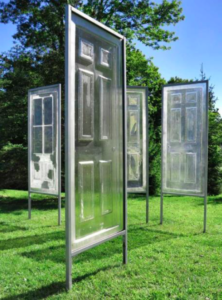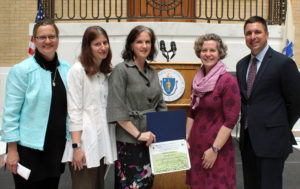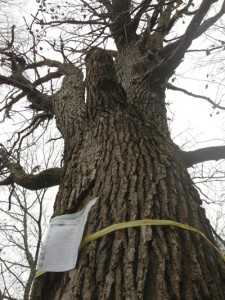The deCordova Sculpture Park and Museum is installing three new outdoor sculptures by artists Saul Melman, Nari Ward, and Josephine Halvorson during May and June.
Melman’s Best of All Possible Worlds is an interactive display of eight translucent casts of doors arranged in the footprint of the artist’s apartment—a ghostly exploration of personal, lived space. Ward’s three concrete casts of goat-shaped lawn ornaments are adorned with a variety of urban debris, commenting on the irony of using human-made materials to improve the natural landscape.
Finally, Halvorson’s Measure (Tree), a hand-painted life-size replica of a fallen tree found near her western Massachusetts studio, was created by the artist to aid viewers in gauging their relationship to the environment.
“Though their works are quite different in appearance, they all heighten our awareness of reality through methods of replication or casting,” said Sarah Montross, associate curator at deCordova. “Each sculpture is a representation of an actual object that has been altered in playful and profound ways: opaque doors are made clear; lively goats are burdened with found materials like discarded shoes; a tree trunk is revealed to be a flat wooden plank.”

Saul Melman, Best of All Possible Worlds, 2012, thermoplastic, paint, wood, and steel, 660″ x 240″ x 128″. Installation view, Aldrich Contemporary Art Museum, Ridgefield, Conn., courtesy of the artist.
DeCordova’s rotation of Sculpture Park loans and commissions will continue throughout the summer with upcoming projects by Nancy Winship Milliken, Cat Mazza, and Andy Graydon.
Best of All Possible Worlds consists of eight vacuum-molded casts of doors, arranged in the exact configuration of the artist’s Brooklyn apartment. The vacuum-cast process creates translucent replicas of the original doors. Traces of paint and small pieces of wood cling to the surface of some of the doors, suggesting their past lives and situating them between the material and immaterial, past and present.
Viewers can walk around the doorways in Best of All Possible Worlds to experience the ghostly echoes of Melman’s lived space. By emphasizing thresholds between interior and exterior, the installation alludes to personal secrets and past experiences that linger in domestic spaces—making a serendipitous connection to deCordova’s own history as a former residence (the opulent home of founders Julian and Elizabeth de Cordova). Melman sited the installation along an east-west axis to activate the doors with the maximum amount of light, particularly during sunrise and sunset.

Josephine Halvorson, Measure, 2016, acrylic on wood, 24′ x 24″ x 5″, courtesy of the artist and Sikkema Jenkins & Co., New York. Photo by Jerry L. Thompson © Storm King Art Center, Mountainville, N.Y.
This work is part of deCordova’s PLATFORM series of one-person commissioned projects by early- and mid-career artists from New England, national, and international art communities that engage with deCordova’s unique landscape.
For his three-part project (Firehose with Libation II, G.O.A.T.; Shoe tips with Libation, G.O.A.T.; and Social Media II, G.O.A.T. [2017]), Ward created a series of concrete casts of goat shaped lawn ornaments. He festooned each of his G.O.AT. sculptures with urban debris such as electrical wire, fire hoses, and old sneakers, attaching the found materials to lengths of rebar extending from the animal’s back. The artist notes that in his birth country, Jamaica, houses are often left with exposed rebar on their roofs to allow for future generations to build additional floors. While Ward incorporates this symbol of growth and possibility into his sculptures, there is also a sense of weight indicated by the objects the animals carry.

Nari Ward, Firehose with Libation II, G.O.A.T., 2017, concrete, sand, fiberglass, red, white and charcoal pigment, rebar, fire hose, eggshell and varnish, 32″ x 10″ x 71.5″, courtesy of the artist and Lehmann Maupin, New York and Hong Kong. Photo: Sara Morgan.
Measure (Tree), to be installed in early June, is a hand-painted replica of a fallen tree the artist discovered near her studio in western Massachusetts. Working on a 24-foot plank of wood, she painted each side to resemble the tree’s characteristics—on one side, daubs of paint convey the bark’s texture while on the other, an illusionistic spray-painted red arrow runs the length of the tree—are fully translating every detail onto the surface of her wooden “canvas.”










